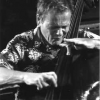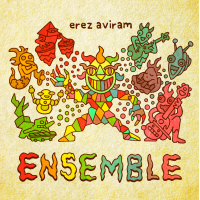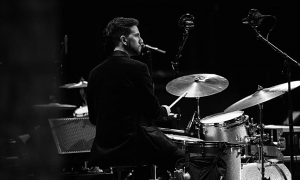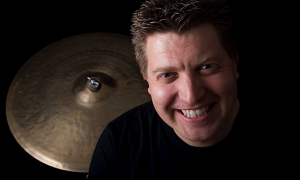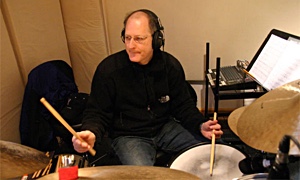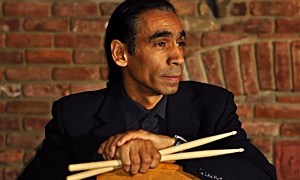Home » Jazz Articles » Rhythm In Every Guise » The Solo Recordings of Ari Hoenig
The Solo Recordings of Ari Hoenig
 As evidenced by his two solo recordings, Time Travels (1K Recordings) and The Life Of A Day (Ah Ha Records), Ari Hoenig is an unusually resourceful artist who transcends the limitations of working with a conventional four-piece drum kit and a few cymbals. Introducing a system of replicating the exact pitches of melodies, Hoenig plays a cornucopia of songs, ranging from jazz standards ("Caravan," "Oleo," "Night In Tunisia") to less-than-fashionable ditties ("Pop Goes The Weasel," "Reveille," "I've Been Workin' On The Railroad"), and integrates improvisations that often quote from the themes. The discs' 36 tracks include a number of Hoenig's original compositions and extemporaneous solos as well. The drumming is vivid and imaginative, yet invariably logical and precisely executed. Even when juggling a number of ideas, there's always a sense of order and structural integrity in everything he plays.
As evidenced by his two solo recordings, Time Travels (1K Recordings) and The Life Of A Day (Ah Ha Records), Ari Hoenig is an unusually resourceful artist who transcends the limitations of working with a conventional four-piece drum kit and a few cymbals. Introducing a system of replicating the exact pitches of melodies, Hoenig plays a cornucopia of songs, ranging from jazz standards ("Caravan," "Oleo," "Night In Tunisia") to less-than-fashionable ditties ("Pop Goes The Weasel," "Reveille," "I've Been Workin' On The Railroad"), and integrates improvisations that often quote from the themes. The discs' 36 tracks include a number of Hoenig's original compositions and extemporaneous solos as well. The drumming is vivid and imaginative, yet invariably logical and precisely executed. Even when juggling a number of ideas, there's always a sense of order and structural integrity in everything he plays. Hoenig takes the melody to Thelonious Monk's "I Mean You" ( Time Travels ) at a sprightly pace, employing single strokes to the snare drum (snares off) and both tom-toms. Some strokes are allowed to ring; others are cut short. The second time through the 8 bar "A" section the light clap of the hi-hat cymbals on beats 2 and 4 undergird the drums and locks in a steady pulse. During the bridge Hoenig's sticking turns skittish as he uses buzz strokes to make an irregular, crunching sound, as well as a closed roll which produces a somewhat smoother rumble; he then returns to singles for a last go at the "A" section. Hoenig drags out the tune's 4 bar conclusion just a bit, temporarily suspending the swinging feeling by dropping the steady hi-hat and emitting a kind of flailing chatter.
A couple of rim shots announce the beginning of Hoenig's acrobatic improvisation. His solo constantly evolves as he rapidly works through a string of brief ideas, always maintaining narrative continuity. (If your attention briefly wanders, when you return he's miles away.) Hoenig thinks very quickly and his execution is always clean. Nothing comes off as flatfooted, labored, or overextended. He never resorts to executing a cliché in order to buy time and figure out what to do next. Sometimes he'll interrupt the aggressively swinging presentation with something that sounds like someone rapidly running up and down a flight of stairs, without losing the solo's overall momentum. On a couple of occasions Hoenig repeats a phrase often enough until it becomes familiar then briskly dashes off to something else.
Throughout the solo Hoenig eschews rolls of long duration in favor of short, choppy sticking and footwork. Early on there's some inspired give and take between the snare and bass drums. Cymbals are struck in ways that are in concert with whatever he's playing on the drums instead of mindlessly crashed. In particular, he gets a lot of mileage from striking the partially opened hi-hat, making a deliciously light hiss that stands in contrast to the terse snap of his stick shots.
Hoenig begins "March For Rudy" ( Time Travels ) with several conventional march cadences, crisply executed on the snare and bass drums, each separated by a couple of beats of silence. The martial rigidity begins to loosen when he makes a couple of hits each to the snare, bass, and tom-tom, letting the last two strokes ring; the simple, sing-song effect lets us know that the complexion of the piece has changed for good. A similar phrase immediately follows and he continues by putting together ideas in four bar segments. Though a swinging improvisational sensibility rapidly emerges Hoenig never abandons the march-oriented and rudimentary rhythms. He recasts and stretches them in different—and sometimes almost unrecognizable—ways; freely mixing in jazz oriented beats, rapidly traveling in short bursts to different parts of the drum set, leaving out the otherwise essential bass drum for significant stretches, and changing the density of the presentation by sustaining cymbal sounds then eliminating them altogether.
 Only 1 minute and 10 seconds long, Hoenig's improvisation "Skins" ( Time Travels ) is a meteoric burst of percussive energy that can simply be enjoyed as such; or, listened to repeatedly in order to take in its elusive development and organization. The solo hurtles along at a wicked pace, but there's no steady pulse per se; at times Hoenig gives the impression of changing speeds. Exhibiting independence of all four limbs as well as a capacity to make each stroke meaningful, he layers rhythm on top of rhythm, yet nothing sounds superfluous; furthermore, despite the compacted nature of the piece Hoenig plays as if nearly everything he touches opens up a world of possibilities to be explored posthaste. There's a sense of the solo traversing a long distance and encompassing various terrain in one manic sprint. He's constantly on the go, simultaneously repeating variations of established patterns (like edgy rhythms played in near-unison on the bass drum and on the hi-hat) while introducing new ones, and making quick shifts that never sound too abrupt or disjointed.
Only 1 minute and 10 seconds long, Hoenig's improvisation "Skins" ( Time Travels ) is a meteoric burst of percussive energy that can simply be enjoyed as such; or, listened to repeatedly in order to take in its elusive development and organization. The solo hurtles along at a wicked pace, but there's no steady pulse per se; at times Hoenig gives the impression of changing speeds. Exhibiting independence of all four limbs as well as a capacity to make each stroke meaningful, he layers rhythm on top of rhythm, yet nothing sounds superfluous; furthermore, despite the compacted nature of the piece Hoenig plays as if nearly everything he touches opens up a world of possibilities to be explored posthaste. There's a sense of the solo traversing a long distance and encompassing various terrain in one manic sprint. He's constantly on the go, simultaneously repeating variations of established patterns (like edgy rhythms played in near-unison on the bass drum and on the hi-hat) while introducing new ones, and making quick shifts that never sound too abrupt or disjointed.
During the first of his three improvised choruses on Charlie Parker's "Confirmation" ( Time Travels ) there's a balance between the pure excitement that one expects from a drum solo and pleasures more cerebral in nature. Hoenig often draws from his canny interpretation of the tune's melody. Rarely more than a few bars pass without the drums at least alluding to something he's played on the head, and as Hoenig forges ahead these snippets are seamlessly integrated into the whole. As he briskly goes from one idea to the next, nothing ever sounds rushed, poorly thought out, or overbearing. Hoenig doesn't use the cymbals all that much, preferring to state his case mostly on the snare with an array of single strokes, buzzes, and stick shots. The tom-tom strokes are allowed to ring out—sounding as if they're about to burst into song. The bass drum is not a constant presence, but rather used as infrequent punctuation, underlining or adding depth to a phrase. The hi-hat that snaps on beats 2 and 4 throughout the head isn't a factor after the improvisation's first few bars. His sticking is what really matters here, and Hoenig's timing is such that a steady pulse is always present without being explicitly stated.
Visit Ari Hoenig on the web at www.arihoenig.com .
Related Article
Bohemian Revolution: Ari Hoenig at Twins Jazz
Tags
PREVIOUS / NEXT
Ari Hoenig Concerts
Support All About Jazz
 All About Jazz has been a pillar of jazz since 1995, championing it as an art form and, more importantly, supporting the musicians who make it. Our enduring commitment has made "AAJ" one of the most culturally important websites of its kind, read by hundreds of thousands of fans, musicians and industry figures every month.
All About Jazz has been a pillar of jazz since 1995, championing it as an art form and, more importantly, supporting the musicians who make it. Our enduring commitment has made "AAJ" one of the most culturally important websites of its kind, read by hundreds of thousands of fans, musicians and industry figures every month.



